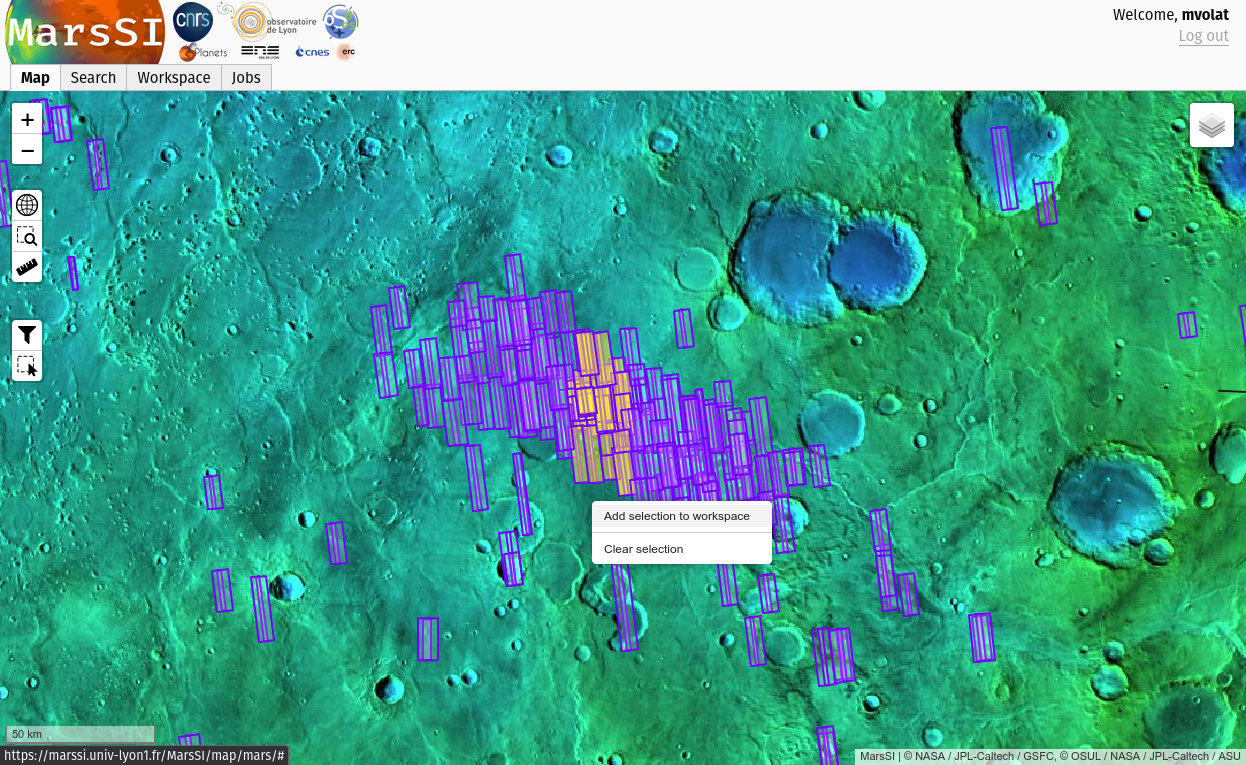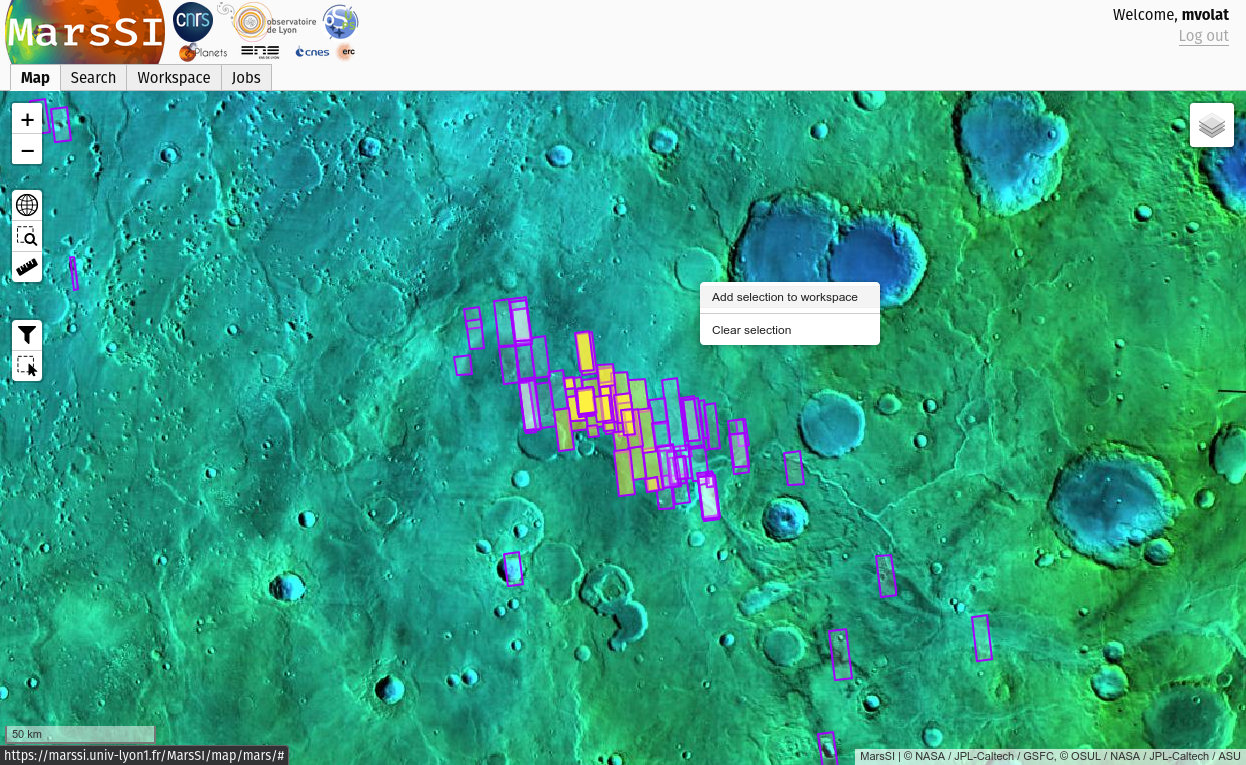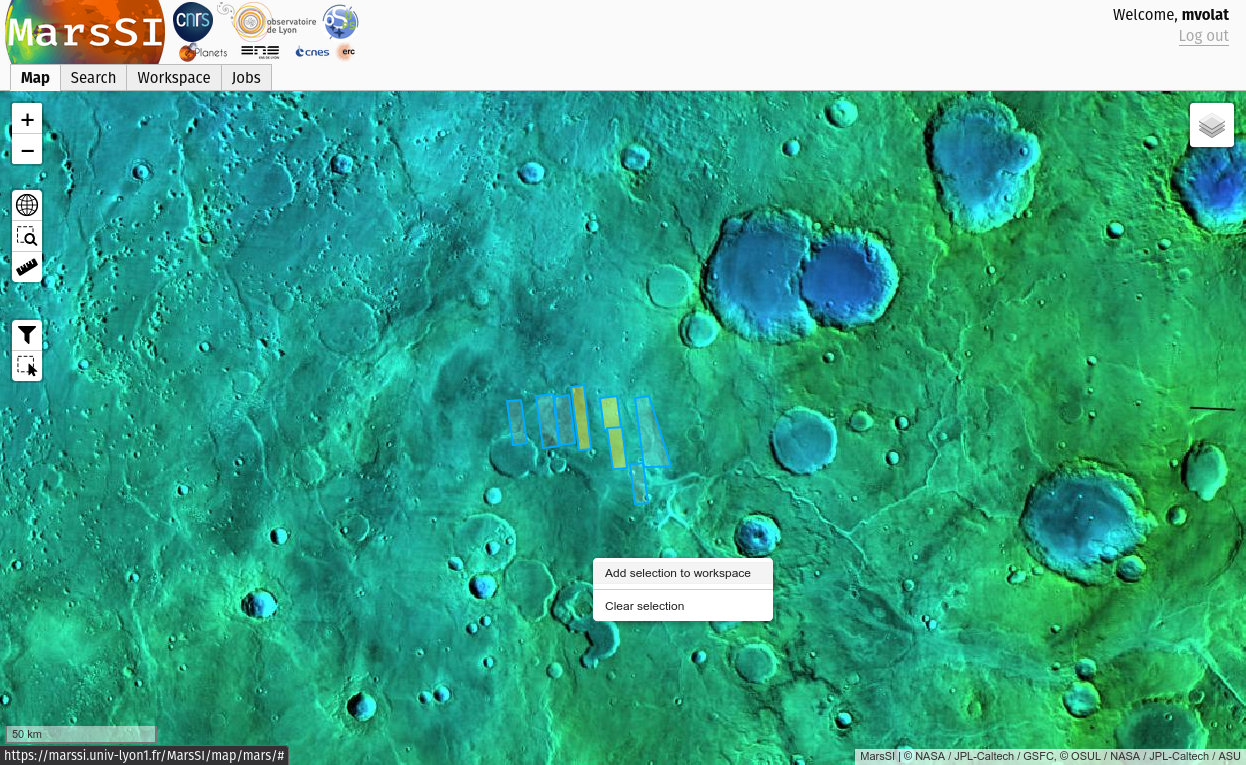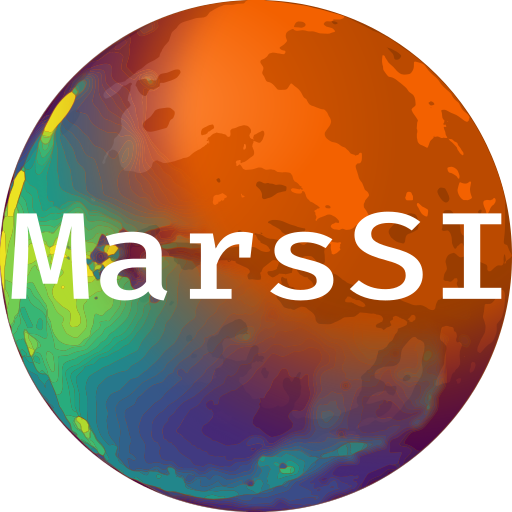The High Resolution Imaging Science Experiment (HiRISE) is a telescope working in orbit in the visible wavelengths and producing high resolution images resolving surface details down to 1-meter size (0.25 to 1.3 m/px). The images enable to study for instance the martian geomorphology but also seasonal surface changes.
Instrument description
The HiRISE camera has 3 different color filtered CCDs: red (“RED”) from 570-830 nm, blue-green (“BG”) less than 580 nm and near-infrared (“IR”) greater than 790 nm. The high-resolution color images enable to distinguish the composition and albedo heterogeneities directly correlated to the geomorphology, complementary to the mineralogic results from the CRISM, HRSC, OMEGA and THEMIS instruments. The RED detectors provide a wide image used for geomorphologic analysis and for stereoanalysis, while the additional detectors are used to create false-color imaging of the central of the swath only (20% of the RED swath width).
Downloading and processing HIRISE data
Imagery
Tutorial
From the “Maps” tab, zoom-in on your region of interest. You can swith to the THEMIS or CTX mosaic for more precision, and then display the HiRISE layer. You can see the HiRISE products footprints that appear in pink. Use the “Select” button to choose the products you desire over an area. Use the right-click context menu to add your selection to your workspace.

In the "Workspace" tab, you will see your product selection. You will notice that there is two type of subproducts: the RED channel with a higher coverage products and the COLOR products (see "Instrument description for more information about coverage and color information). HiRISE color images are downloaded calibrated and with georeferencement, there is no more processing on this data type. HiRISE RED images can be processed in different steps: first a raw product (EDR) is downloaded. It can be processed into a calibrated RDR product. The last step reproject and georeference the RDR product into a MRDR image.
Check the product status: if some data is not already done yet, select the rows you would like to request by ticking the input on the left column (you can use the "Select all" button to select all visible products) and click on the "Process" action on the top of the workspace table. You can check more information about the processing in the job tab if needed.
Once all the data you would like is done, select entries by ticking the input on the left column (you can use the "Select all" button to select all visible products) and click on the "Copy" action to request a copy of the data in your personal directory. You can then proceed to download products as described in the SFTP section.
Pipeline information
The pipeline for the topographic mapping derived from HiRISE images uses both the USGS ISIS system (the ISIS 3 system).
MarsSI Digital Elevation Models
Tutorial
In order to realize a HiRISE DEM, you must have processed the related HiRISE RED imagery up to the RDR level, asdescribed in the previous section.
From the “Maps” tab, zoom-in on your region of interest. You can swith to the THEMIS or CTX mosaic for more precision, and then display the HiRISE-stereo layer. You can see the HiRISE-DEM products footprints that appear in blue. Use the “Select” button to choose the products you desire over an area. Use the right-click context menu to add your selection to your workspace.

In the "Workspace" tab, you will see your product selection.
Check the product status: if some data is not already done yet, select the rows you would like to request by ticking the input on the left column (you can use the "Select all" button to select all visible products) and click on the "Process" action on the top of the workspace table. You can check more information about the processing in the job tab if needed.
Once all the data you would like is done, select entries by ticking the input on the left column (you can use the "Select all" button to select all visible products) and click on the "Copy" action to request a copy of the data in your personal directory. You can then proceed to download products as described in the SFTP section.
Pipeline information
The DEM footprints have been created automatically based on the percentage of intersection and the difference in emission angle between the two input images. Please be advised that DEM creation process can fail due to other parameters. See DemErrors for more information.
The HiRISE DEM images created by MarsSI are generated using the NASA AMES Stereo Pipeline (http://ti.arc.nasa.gov/tech/asr/intelligent-robotics/ngt/stereo/).
HiRISE Team Digital Elevation Models
Tutorial
From the “Maps” tab, zoom-in on your region of interest. You can swith to the THEMIS or CTX mosaic for more precision, and then display the HiRISE-team-DTM layer. You can see the HiRISE-DEM products footprints that appear in light blue. Use the “Select” button to choose the products you desire over an area. Use the right-click context menu to add your selection to your workspace.

In the "Workspace" tab, you will see your product selection.
Check the product status: if some data is not already done yet (for HiRISE team DEMs, this only means downloading it), select the rows you would like to request by ticking the input on the left column (you can use the "Select all" button to select all visible products) and click on the "Process" action on the top of the workspace table. You can check more information about the processing in the job tab if needed.
Once all the data you would like is done, select entries by ticking the input on the left column (you can use the "Select all" button to select all visible products) and click on the "Copy" action to request a copy of the data in your personal directory. You can then proceed to download products as described in the SFTP section.
Pipeline information
This dataset was created using the commercial stereogrammetric software SOCET SET and tuned by hand by the HiRISE team. The DTMs have a 1-meter spatial resolution and 25 cm vertical precision. For more details about the process used to create HiRISE DTMs, see Kirk, R.L. et al. (2008).
Data description
Images
Directory content
The content of an HiRISE product directory in MarsSI should look like:
- ESP_011261_1960_RED*_*.IMG
- raw red data (EDR), multiple files
- ESP_011261_1960_RED_RDR.cub
- reflectance (irradiance/solar flux or I/F) called Radiometric Data Record, stitched in a single image
- ESP_011261_1960_RED_MRDR.tif
- projected and georeferenced image from the RDR
- ESP_011261_1960_COLOR.tif
- projected and georeferenced color image (RDRV11)
Georeferencing
Due to the ISIS format, probably only some GIS software will be able to display RDR products, but only the MRDR products have georeferencing and can be displayed in a true geographic view.
MarsSI Digital Elevation Models
Directory content
The content of an CTX-DEM product directory in MarsSI should look like:
- HI_022288_2035_022354_2035-ALIGN-DEM.tif
- DEM product, aligned to MOLA
- HI_022288_2035_022354_2035-ALIGN-DRG.tif
- left image aligned and orthorectified along the DEM at its resolution
Older directory could include non-aligned DEM/imagery.
HiRISE Team Digital Elevation Models
Directory content
..
References
- HiRISE instrument and data website: http://hirise.lpl.arizona.edu
- HiRISE DTM creation explanation: http://www.uahirise.org/dtm/about.php
- HiRISE instrument description paper: McEwen, A. et al. (2007). J. Geophys. Res., 112, E05S02, doi:10.1029/2005JE002605.
- HiRISE DTM description paper: Kirk, R.L. et al. (2008). J. Geophys. Res., 113, E00A24, doi:10.1029/2007JE003000.
- USGS ISIS software: https://isis.astrogeology.usgs.gov/
- Ames Stereo Pipeline: https://ti.arc.nasa.gov/tech/asr/groups/intelligent-robotics/ngt/stereo/
